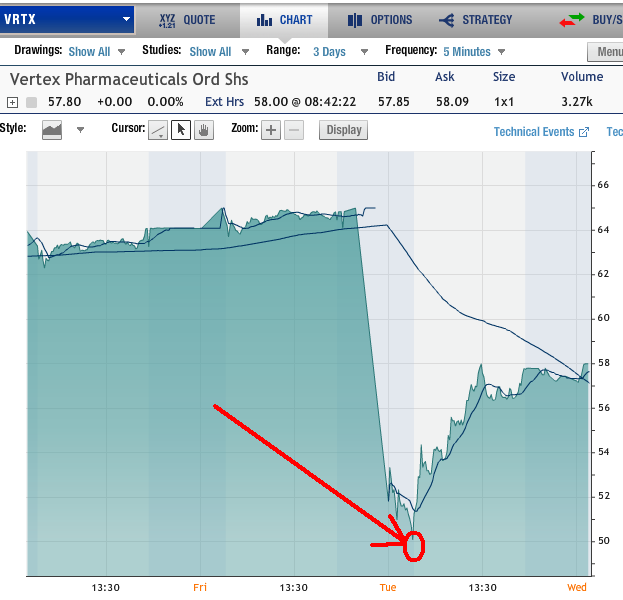By Jon “DRJ” Najarian
Pete and I frequently speak of “Amateur Hour,” the first 60 minutes of every trading day. Some hear us mention this and take offense, as if we are making fun of retail investors. Nothing could be further from the truth.
The two of us founded our brokerage tradeMONSTER to help individual investors by providing them with as many understandable and accessible tools as possible. We also offered commissions at the most economical level in the industry because we understood that the more someone trades, the more commissions can be a drag on performance.
So what is Amateur Hour, and why do so many professionals focus on it?
We all know the line from the Robert Burns poem “To a Mouse,” in which he writes: “The best laid schemes of mice and men often go awry.” This is particularly true in trading.
We do extensive research and draw our plans carefully, including entry and exit prices for either profit or loss. But then a guest on CNBC comes on an hour before the market opens and makes the case for the polar opposite of the strategy you have so dutifully laid out. Next thing you know, stocks are opening in negative territory.
Instead of sticking with your plan, keeping your hand steady on the tiller, you are suddenly driven by the winds towards the rocks. And instead of reassuring yourself that your strategy remains intact and you are getting in at a better price, you are paralyzed. Or, worse yet, you flip 180 degrees and go with the wind, thinking that this is “trend following.”
In other words, you just threw away several hours or even days of prep work to chase the market up or down in those first few minutes of trade. The S&P opens down 10 “handles,” or points, and instead of buying according to your painstakingly formulated thesis, you sell. Or, conversely, the Dow runs up 60 or 90 points and you jump in despite having an extremely negative outlook based on the belief that the market was overvalued.
Both are great examples of why professional investors call this Amateur Hour.
Yesterday (May 29th) was a great example of Amateur Hour, as the panic over their Cystic Fibrosis drug pushed shares to the lows of the day in those first 60 minutes, and then shares bounced once the panic subsided. Thus, as we wrote ahead of the open, if you get that flush, don’t be the chump that sells, but if your have the stomach and bullets, use the drop as an opportunity. Those that bought shares of VRTX at or below $50 and took $8 faster than you can say FAST MONEY, and those that followed that Amateur Hour trend just gave their money away. At least in Vegas they buy you drinks!
What you should do instead is stick with your conviction. Whether it’s an earnings announcement, a new product, an FDA drug approval, or some other catalyst, don’t abandon your strategy; don’t take that first hour as the trend, but rather as the fade.
Why complicate the markets? The old phrase “Keep it Simple Stupid” is as true today as it has ever been. You needn’t take the path that too many struggle to follow, as maintaining focus can improve your returns and ease your mind.
Along those lines, many investors allow themselves to get overwhelmed with data that has become so easily obtained on the Internet. We’ve never had so many informed investors, trading with narrow bid/offer spreads and nearly free commissions, struggle so mightily to make a profit.
My friend Dave Landry, a market technician from New Orleans and a published author, gave me a copy of his most recent book–all three pages of it. The simplicity of its message proved irresistible at a recent conference we spoke at in Italy.
The first page showed the uptrend, in which the chart rises from the lower left to the upper right. That was followed by the bearish chart that runs from upper left to lower right. The last page showed at flat line representing sideways markets.
When you and I are trading any of these three scenarios, we need to remain focused on which market we are in and ride that trend. But keep in mind that Amateur Hour isn’t the trend–it is rather the reaction to trading in Asia and Europe. That first hour is playing catch-up to markets that were open when ours were closed.
Of course, any of you who have traded for any length of time know that it’s not quite that easy. The market can be in a downtrend, but just try to ride out those short-covering rallies and you’ll see how easily you can be shaken out of your conviction.
So your choices are simple. You either need to trade full-time–which means getting in and out of dozens or hundreds of positions each day as I do–or you can establish call spreads or put spreads that are less susceptible to short-term moves against the trend you are following.
This is precisely how option strategies can help you maintain your objective outlook rather than getting pulled in every direction on a given stock or ETF.
Jon ‘DRJ’ Najarian is co-founder of optionMONSTER® and co-lead analyst for the InsideOptions™ trade idea alert systems. He spent the first 29 years of his trading career trading in and around the pits of the Chicago exchanges. Jon is a frequent contributor to CNBC, the Wall Street Journal, and other prominent financial media organizations. Mr. Najarian also co-developed the patented trading algorithm the Heat Seeker®, used to detect unusual trading activity.


